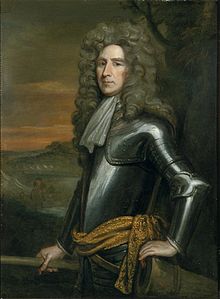Henry Sydney, 1st Earl of Romney
This article needs additional citations for verification. (August 2012) |
The Earl of Romney | |
|---|---|
 | |
| Secretary of State for the Northern Department | |
| In office 1690–1692 | |
| Preceded by | The Earl of Nottingham |
| Succeeded by | The Earl of Nottingham |
| Personal details | |
| Born | 8 April 1641 |
| Died | 8 April 1704 (aged 63) |
Henry Sydney (or Sidney), 1st Earl of Romney (8 April 1641 – 8 April 1704) was an English politician and army officer. Often dismissed as a mere flunkey and court favourite, he was nevertheless an expert Statesman, with an adroitness for manipulating men. He was one of the Immortal Seven, and in fact the author of the invitation that group extended to their future King.
Life
Born in Paris, a son of Robert Sidney, 2nd Earl of Leicester, of Penshurst Place in Kent, England, and his wife, born Lady Dorothy Percy, a daughter of Henry Percy, 9th Earl of Northumberland and sister of the 10th Earl, he was brother of Philip Sidney, 3rd Earl of Leicester, who was born in 1619; brother Algernon was raised at Penshurst Place - a beloved of early triumphant Whiggism (the causes of parliamentary supremacy and republicanism like John Locke) and in late life executed in 1683 convicted as author of the "Rye House Plot" against the quite popular late monarch Charles II; and Robert Sidney. Henry's sister was Dorothy Spencer, Countess of Sunderland.
Sydney entered Parliament in 1679. He was employed by Sunderland to negotiate with William of Orange in 1688, and was one of the signatories to, and the actual author of, the cipher sent to the Prince calling for the Glorious Revolution. In the upshot, when King James II & VII was deposed under legislation (from his brother Charles II's reign) intended to bar him from the succession, the new King created Sydney Baron Milton and Viscount Sydney in 1689.
He was present at the Battle of the Boyne in 1690, and was later to become employed by King William as envoy to the Hague and also served as Lord Lieutenant of Ireland for the period between 1692 and 1693 and was created Earl of Romney in 1694, but began to lose favour at the court under Queen Anne.
Henry Sidney served as Master-General of the Ordnance from 1693 to 1702. Additionally, he was a Lieutenant-General and Colonel of the First Regiment of Foot Guards (Grenadier Guards). He employed the Sidney family emblem, the pheon or broad arrow, on prison uniforms and other government property.[1]
In 1694, Sydney succeeded the Earl of Dorset as Chief Ranger of Greenwich Park in London. He built a diversion of the main road from Woolwich to Deptford so that it ran between the Queen's House and Greenwich Palace, its present course. Part of the road is called Romney Road after him.[2]
He died unmarried, in London, "a proud but drunken man",[citation needed] aged 63.
The University of Nottingham Library contains a catalogue of the papers of Hans William Bentinck, 1st Earl of Portland, which outlines much of Sidney's correspondence.
There further have survived 98 letters between Sidney and George Legge, 1st Baron Dartmouth, which include papers written by Dartmouth during his confinement at the Tower.
References
- ^ Army ordnance, Volume 14, American Ordnance Association, 1933, p. 162. "he caused his arms, a pheon, or double broad- arrow, to be cut on all Crown property, a practice that has survived to this day" Philip Sidney, The Sidneys of Penshurst, 1901, p. 262. "perhaps his greatest claim to fame lies in the fact that, as Master of the Ordnance, he adopted the broad arrow or 'pheon' of the Sidneys as the mark of government property." Keith Spence, The companion guide to Kent and Sussex, 3rd ed. 1999, p. 204.
- ^ The London Encyclopaedia (reprint ed.). Macmillan. 1992. p. 651.
{{cite book}}: Unknown parameter|authors=ignored (help)
- Use dmy dates from August 2011
- 1641 births
- 1704 deaths
- Earls in the Peerage of England
- Peers of England created by William III
- English generals
- Grenadier Guards officers
- Lord-Lieutenants of Kent
- Lords Lieutenant of Ireland
- Lords Warden of the Cinque Ports
- Members of the Privy Council of England
- People from Paris
- People from Penshurst
- Younger sons of earls
- Williamite military personnel of the Williamite War in Ireland
- Ambassadors of England to the Netherlands
- English MPs 1679
- English MPs 1689–1690
- Grooms of the Stool
